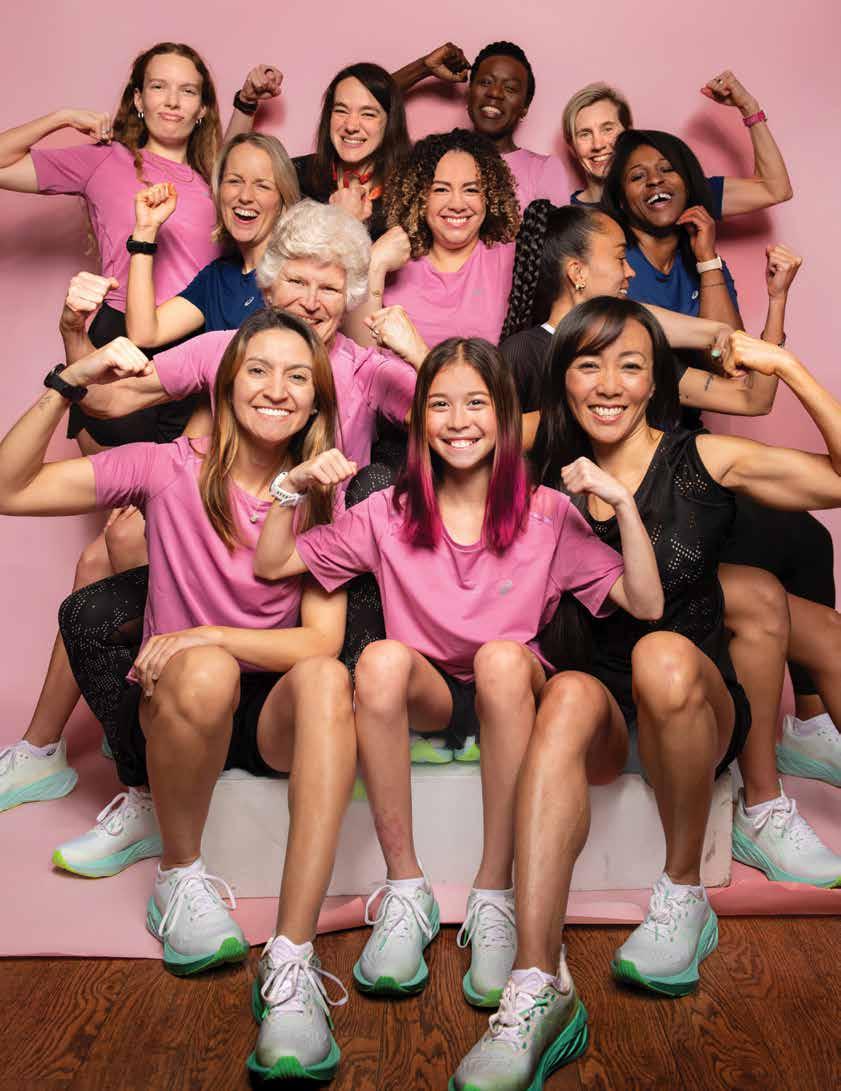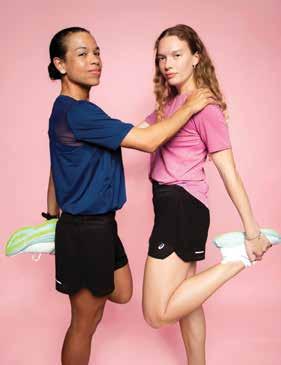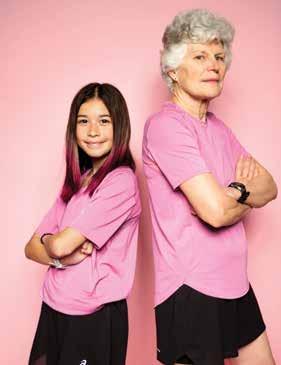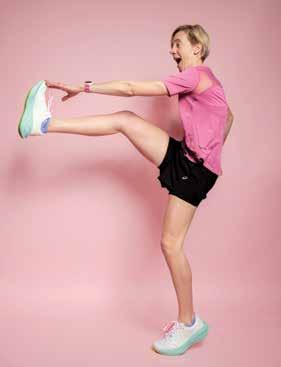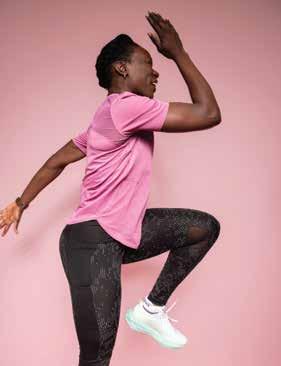






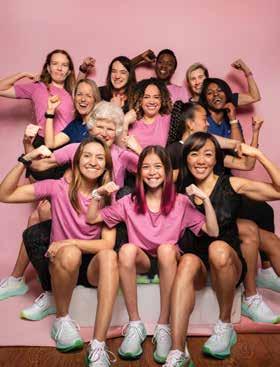
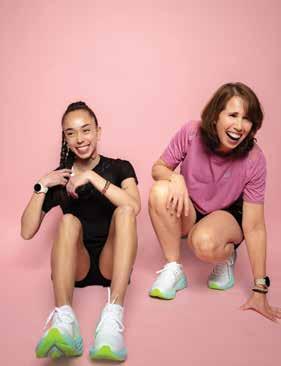
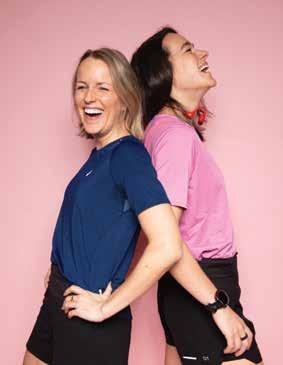
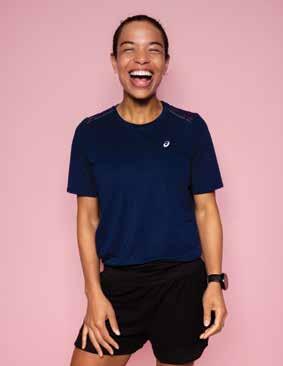

 The official magazine of iRunNation
The official magazine of iRunNation








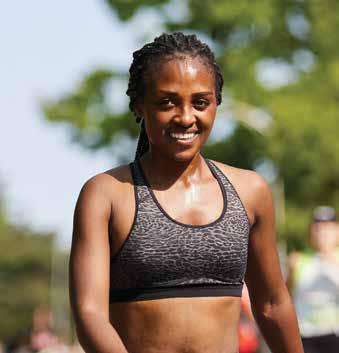
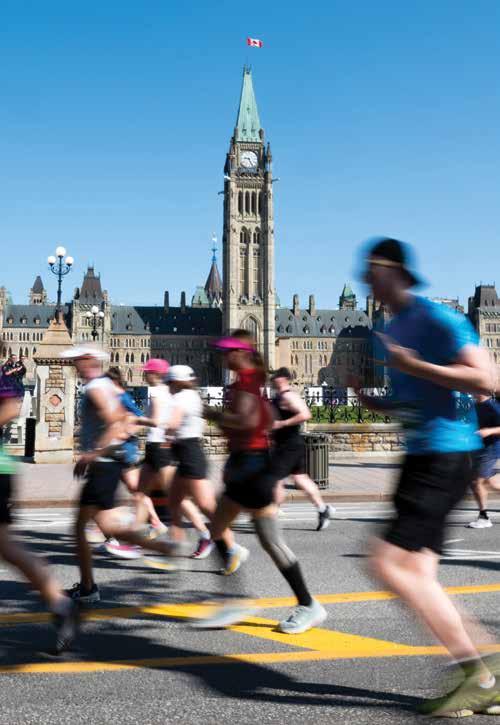



The hottest new releases that will have you ready for the season, whether you’re out for an easy run around the neighbourhood or giving it everything you’ve got to PB this season.

Its flat-knit upper is designed so that it molds to the foot like a sock, while the PEBA midsole foam provides cushioning and energy return and convex carbon fibre plate bows midway for a suspended feeling.
HOKA
Skyward X, $225i

Take Salomon’s proprietary Active Chassis for support and stability and add cushiony Energy Foam midsole to provide guidance to your stride and added confidence with your step.
Salomon
DRX BLISS, $200i


Designed with cushioning as a priority with soft glide through the midsole foam, for starters, plus an outsole that provides solid traction and flexion, giving you a comfortable, balanced run.
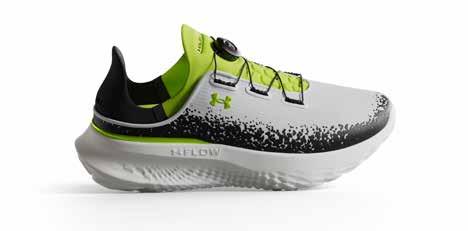
“More passion! More energy!” You deliver the passion, while the Nike Pegasus 41 promises to provide more energy return thanks to a fulllength ReactX foam midsole, forefoot and heel Air Zoom units (think upwards of 13 percent more energy return compared to React foam).

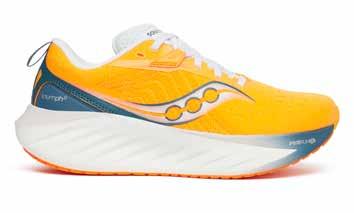
Additional midsole height provides more cushioning while a new single part midsole provides a lighter weight ride. Cozy and wearable–and with recycled bottle content in the upper. iNew Balance Fresh Foam 880v14, $179.99 i
“
Ken Rideout was an addict on Wall Street. Now he’s a marathon champion, drinking Athletic Brewing and running the happiest, fastest times of his life.
By Ben KaplanKen Rideout is 53-years-old and to prepare for his first marathon, he’d run twenty miles once per week along the beach near his home in California, progressively getting faster with each mile he’d complete. Starting at seven minutes-per-mile, he’d gradually run harder—speeding up until he reached quicker than six minutes-per-mile to finish his work.
When it was over, he’d collapse on the sand.
“Beyond hardcore, but that was always the intensity I brought to hockey and football and, of course, in the boxing ring,” says Rideout, whose toughness and candor have made him one of our sports’ most popular new runners.
Rideout’s long list of accomplishments includes several first-place finishes in the 50-54 age group at the Abbott World Marathon Majors, including the 2023 Chicago Marathon, the 2023 Tokyo Marathon, and the 2022 Boston Marathon. He also emerged as the Masters (40+) winner at the 2021 New York City Marathon and claimed victory at the 2023 Gobi March, a grueling 155-mile, self-supported, 7-day ultramarathon through Central Mongolia.
“Without running, I’d be an anonymous loser, an addict worrying about making money as opposed to what the sport has given me: setting myself up as an example for my children. Running has given me everything.”
Rideout, who co-hosts a wildly popular podcast with the boxing legend Tony Atlas, takes his ring toughness to endurance running and his finishing time PB of 2:28:25 at the California International Marathon in 2019 has gotten international attention. As it is for many of us, Rideout says the appeal of running goes beyond his physical health. He runs to stay on the healthy—spiritual and mental—path.
“Running has given me an awesome outlet to be aggressive without being a jerk and all this pent-up frustration and anxiety about all the time I wasted with my addiction, running gives me an opportunity to harness it and almost use my suffering as an art form,” says the three-time Ironman World Championship qualifier. “I never had running when I was younger, I wish I did. I’m making up for it now.”
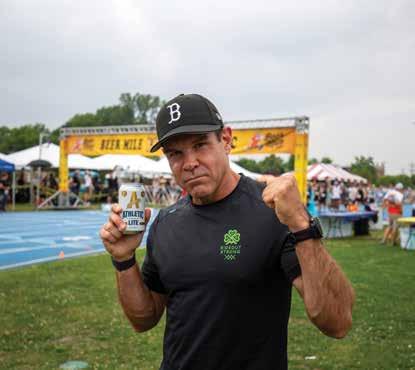
Like a lot of athletes, Rideout has incorporated Athletic Brewing into his training program. He says he no longer hears the siren call of drugs or alcohol, but sometimes, after a race or hard workout, he does miss the sensation of popping the top of a drink. Athletic Brewing, called the Hottest Beer in America in February by the Wall Street Journal, is non-alcoholic, and has changed the Pavlovian responses to how we express satisfaction and joy.
“Athletic has been like a godsend, meeting their team and drinking their brews,” Rideout told iRun, who has partnered with the company since 2023. “Somehow after races, the natural cycle occurs where I crave something and I have Athletic, and when I feel overwhelmed that feeling gets replaced with something I’d describe as like gratitude.”
Athletic Brewing’s award-winning non-alcoholic beers are available at over 2,000 retail locations across Canada, including Loblaws and the LCBO. Sponsoring the marathon at Tamarack Ottawa Race Weekend and filling the fridge at independent running shops like Toronto’s BlackToe Running, the product has made an indelible impact on the running world.
The running world, says Rideout, is a world that makes him feel safe, strong, engaged, and empowered. He wants to run more ultramarathons and I asked him if his move from the marathon to ultramarathons was because—like what happens to a lot of runners of a certain age—he felt like his marathon time could no longer get any faster. He flashed his famous grin, dropped a few F-bombs, and said this: “I ran 2:29 in October and my prep wasn’t great, my diet wasn’t great and I know I can run the marathon faster,” he said. “When I’m racing, I tell myself I’m tougher than anyone. I trained harder than anyone. I’m meaner than everyone. I only have to convince myself by 1% that it’s true and if 99% of me is filled with self-doubt and fear, I can ignore that part and keep training and working. That’s why I fell in love with running and that’s why I do what I do.”
Athletic Brewing offerings are distributed in the United States, Canada, the United Kingdom, and parts of Europe. To order and find your closest locations, visit athleticbrewing.ca.
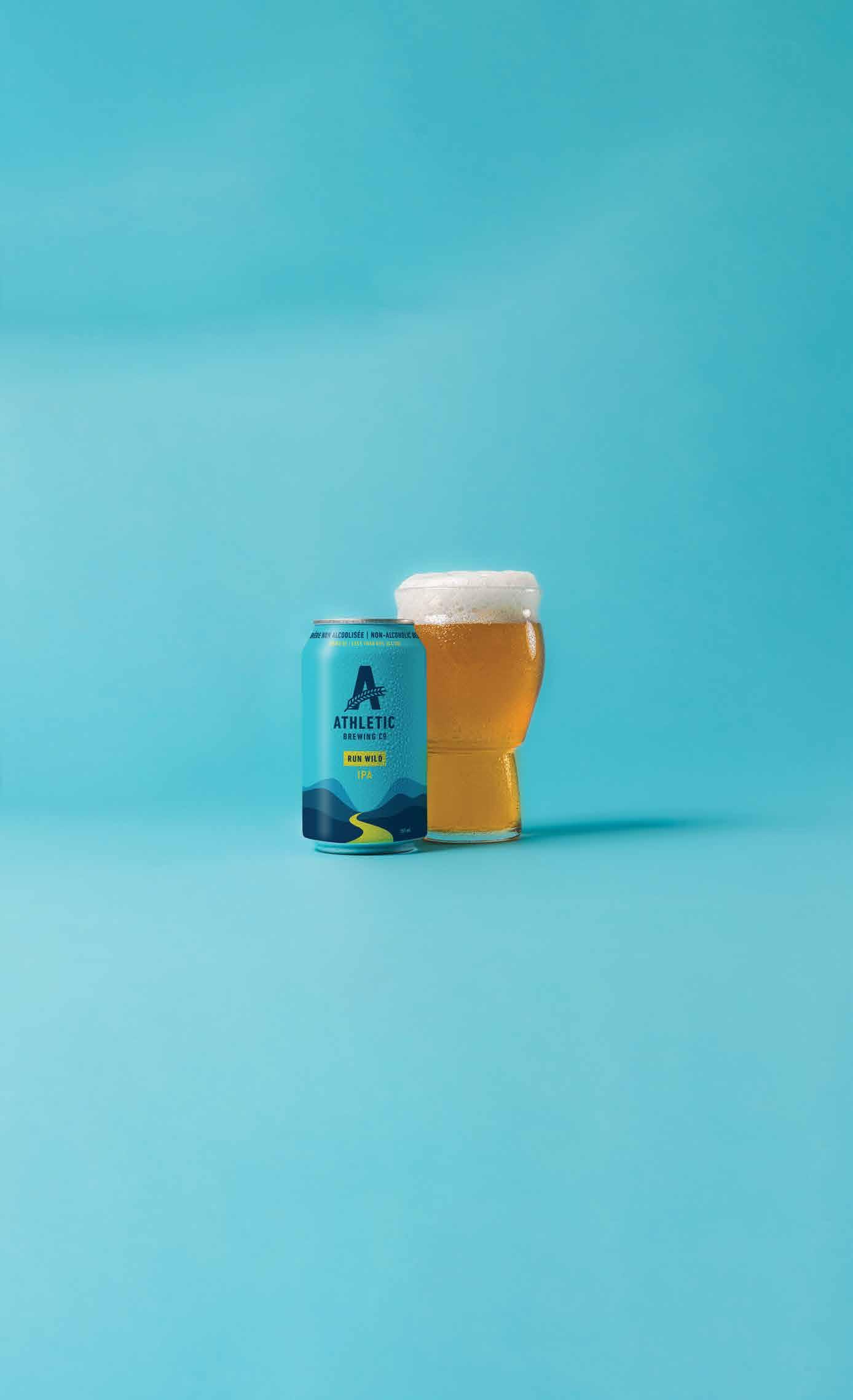

It’s Spring 2024. Races are underway, the first three world major marathons of the year, Tokyo, Boston, and London have been run, winners crowned, newly minted 6-star marathoners are relishing their awesome achievement. Here in Canada we’ve got some of our most anticipated races of the year, including the 50th anniversary of the Tamarack Ottawa Race Weekend, the 60th anniversary of the Servus Calgary Marathon the same weekend, and a west coast favourite Canadian Running Series’ Vancouver Half Marathon. We survived winter training and we’re ready to get out and celebrate with the community on the roads and trails of our cities and towns.
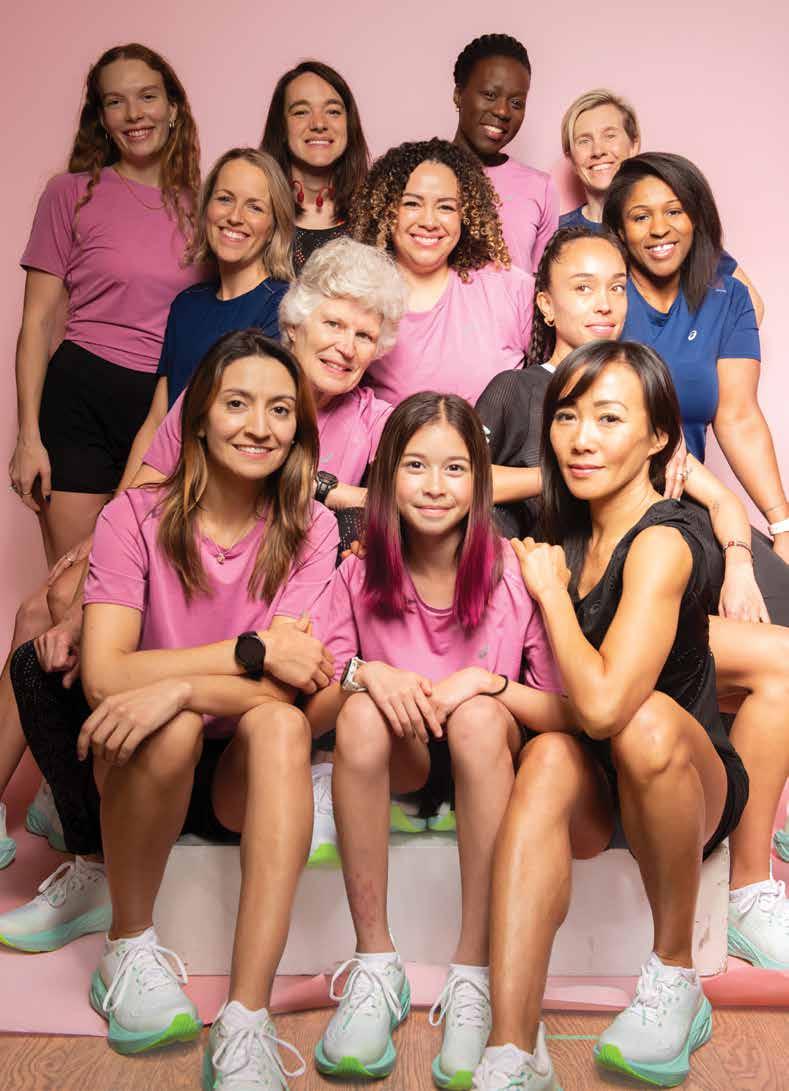
Let me share a little more about what ASICS learned through the Move Her Mind Study:
1 Physical activity is positively linked to a women’s state of mind —the more the exercise the better the feel.
2 Despite knowing this, more than half of women are not exercising as much as they would like to—working women, mothers and homemakers were the least active across all women.
3 Motherhood is a challenging time to remain active— between gendered expectations about caregiving and household responsibilities women drop out of their regular exercise routine.
4 As women age their activity levels decrease—several challenges and barriers make exercise challenging for women.
5 The three most reported barriers include lack of time, other commitments, and the cost to be active.
It’s a great time for our sport. Attendance is up at races, and new people are becoming involved. Many of us are excited about the approaching Olympic and Paralympic Games, and over and over again we hear about gender parity and an equal number of men and women competing in the upcoming Paris 2024 Games.
Many women reading this, however, face a number of barriers that prevent them from reaching a level of fitness they wish could. While research has been done on the barriers to exercise for women, to date not much has been shared on how to overcome these barriers—no toolkits have been created to minimize the gender exercise gap between men and women. Until now.
In 2022, ASICS set out to understand our state of mind while exercising. We were still in a pandemic, and the fatigue of the isolation was wearing us all down. Despite this, the research showed that as little as 15 minutes and 9 seconds of physical activity daily demonstrated a positive impact on the world’s mental health. The team also uncovered a gender exercise gap; women were exercising far less than their male counterparts. Instead of leaving the findings there, ASICS began to develop a toolkit to help women be more active.
Enter the ASICS Move Her Mind Study.
ASICS engaged with leading movement and wellbeing researchers, Dr. Dee Dlugonski, Assistant Professor at Sports Medicine Research Institute, University of Kentucky, and Associate Professor Brendon Stubbs of King’s College London. Using an evidenced-based approach, the team created a survey and hosted focus groups across the world. 26 focus groups took place and almost 25,000 people completed the survey in over 40 countries.
What do we know? “The more women move, the better women feel.”
Yet, over half of women are dropping out or stopping exercise completely, and all women are facing a myriad of barriers to exercise throughout their lifetime.
With the Move Her Mind study, when we asked men what they thought the main challenges women faced when it came to remaining active, they cited body image insecurity, fear of harassment, and fear of judgment. While these are some of the barriers for women, these are not the primary barriers and challenges women face.
These findings are not unique. This is supported by work I and my colleagues do in the Mental Health and Physical Activity Research Centre at the University of Toronto; we’ve found similar results when it comes to the barriers that girls and women face when it comes to exercise and movement. What can we do to make exercise and movement more accessible for women?
When ASICS interviewed me as part of their work,
I suggested that, “We need to reframe the meaning of physical activity and not allow ourselves to be shamed into exercise culture. Personalization and accessibility are key—we must empower women to do what’s best for them. Even a short power walk or running around with children in the park should be viewed as physical activity!”
1. Creating accessible, affordable, safe, and inclusive spaces for women within sport and exercise. Allison Hill and Hill Run Club, “a body positive, size inclusive, culturally sensitive, mindful running club” are a wonderful example of this here in Toronto. Meanwhile, Tarrant Crosschild and Prairie Run Club in Saskatoon are doing great work to make running more accessible to everyone, and they’ve got a fun women’s only track event coming this spring. Tréchelle Bunn, created the Reconciliation Run in Manitoba to honour her grandparents, which created an inviting and inclusive way for others to participate in running events.
2. Educating everyone about the specific needs of women and girls. I’m on a mission to destigmatize the menstrual cycle across the lifespan. From saying the word ‘period’ to ‘bleeding,’ talking more about pregnancy, perimenopause, and menopause, we all play a role in understanding girls and women’s needs. There are some easy wins with this one. Have a stash of period products. Talk openly about the menstrual cycle and how it can affect training—from the emotions to the physical effects.
3. Using visual representations of real women. For instance, this iRun cover. If you manage a social media account, think about who is represented and more importantly, who are you missing? If you’re a race director, ensure women represent half the start line, use a diversity of women’s images in the pre- and postrace media, and ensure cutoff times are welcoming for all participants.
4. Challenging gendered expectations for girls and women. This is for the men, but also for us women to remember—we don’t have to fall victim to gendered expectations. Make women’s exercise is an equal priority. Divide household chores and caregiving. Better yet (and some of my favourite childhood memories), what can you do together as a family to be active? Walk or hike your local city, provincial or national park. Walk, run, or wheel together to get to school. Most importantly, make sure we check in with the women in our lives to ensure they’re meeting their desired physical activity levels—and if not, be part of the solution to make that happen.

While the Paris 2024 Olympics may reach gender parity, we still have a ways to go to make physical activity and exercise more accessible and available to all women. Here’s what ASICS learned about facilitators behind exercise to help women get or remain active:
1 Setting and meeting personal physical activity goals.
2 Using technology, such as phones, smart watches, and apps to hold them accountable and to track their progress.
3 Having access to safe exercise spaces and equipment.
4 Signing up for a race or event.
5 Being active with friends and teammates.
Movement and exercise have the power to change the world. By switching to walking, running, or biking for some of your commutes, whether it’s to the local store, to work, or to get the kids to school, these daily movements will make your mental and physical health better. Running is for every body. It is the job of us to ensure everyone has equal access to health.
The creation of so many female-based (non-exclusive) run groups has been fantastic, but we need to take it further. New mum groups that work around childcare schedules or run groups that cater to the 50+ set are another idea. When you are just starting out on your running journey it can be intimidating to join a group—especially when the majority of the runners are young. Maybe I’ll start one for the old ladies.
Representation is key. I have so many friends that have stopped participating in sports or any kind of physical activity because they feel too old. They quit sports once they had kids and haven’t gone back. Seeing other women their age and older participating has to be motivating and a reminder: they aren’t too old to start.
Movement should be part of all of our lives. Exercise is important, but if fitness is something separate from the rest of your life it can become just another thing on your to-do list and the first thing to fall by the wayside when life gets busy. Change the way we think about running. Movement is about more than just looking good. It’s important for brain health and to live a long and healthy life.
Running is a deeply solo sport to me, like a private conversation with myself. But running with Allison Hill and Hill Run Club showed me that when you join up with others who lift you up, cheer you on, believe in you, you can fly. As a relatively new runner, I find it intimidating to be around capital R runners, but the Hill Run Club community has made me feel like I belong, that running is for me, too, and that you can go further and faster surrounded by people who believe in you. If not for Hill, I would’ve never signed up for a race. But I’ve run two 5ks, and will be running my first 10K at the Sporting Life 10K in May. Peer pressure— and running in community—works!
Everyone needs to find movement that makes them feel good—or alive. It doesn’t have to be measured, that’s often discouraging to many women. You don’t have to count steps or kilometres. Every little bit adds up and is something. Something is better than nothing. Find ways that make you feel better in some way for the doing of it—happier, proud of what you did, more energized, relieved of stress, pleasantly relaxed, more
capable of going back to the rest of your life. You might feel tired or sore during this movement, but consider more how you feel afterwards, and in the long-term. Do things that make you feel like a kid again: jump off that curb or over that little hedge or jump up to that basketball net or run to the park with your kids or after your dog. Stretch like your cat. Just move.
When women first start to experience a new form of movement, what’s important is the exploration of that movement, and then the consistency. We move, we like it, we return to the activity again, and then establish the routines and habits to continue, and maybe come up with goals. Then we have the motivation to continue—to go back to the gym to lift weights, to learn new yoga poses, to figure out ways to run faster next time.
Highlight successful female athletes within communities so that they can inspire other women and girls to be active or want to pursue sport. Establish female-led mentorship programs so that they can mentor young girls like me and provide valuable guidance and support. Organize more female-only events, such as the Toronto Women’s Run Series that I participated in last year. These events help to build a culture of togetherness and make sport feel like a safe and welcoming environment. When women and girls feel supported by their peers and mentors, they are more likely to take part and stay committed.
Running is a way to challenge my body and my head. It’s a way to meditate, a way to think, and also a way I use to forget about life in general. It’s a way to get out my everyday frustrations, it’s my safe space, it’s like a bubble for me.
Not everybody wants to run alone so we need to educate people about the existing running spaces. We also need to find, adapt and create spaces where everyone is welcome. Make these spaces and the movement in these spaces more inclusive. Create environments and practices that ensure everyone feels welcome—with options and levels of activity for everyone. And then working hard to communicate that those spaces exist.
Remember movement—it’s not necessarily a sport, or competition, or being a super fit person: movement goes beyond that. It’s about health. It’s about re-educating people to let them know how important exercise is for the mind.
We asked women from our cover shoot what they thought were some good solutions to the Gender Equity issue, and this is what they said.


“I have so many friends that have stopped participating in sports or any kind of physical activity because they feel too old. They quit sports once they had kids and haven’t gone back. Seeing other women their age and older participating has to be motivating and a reminder: we’re never too old to start.”
— MAUREEN BUCKLEY
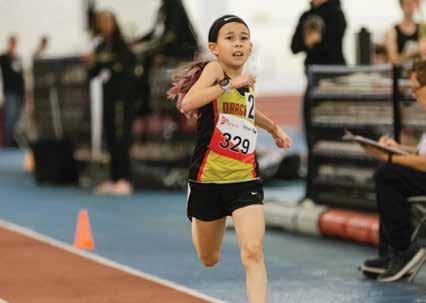
“Events build a culture of togetherness and make running feel like a safe and welcoming environment. When women and girls feel supported by their peers and mentors, they are more likely to take part and stay committed.” — SAWYER NICHOLSON



“As a relatively new runner, I find it intimidating to be around capital R runners, but the Hill Run Club community has made me feel like I belong, that running is for me, too, and that you can go further and faster surrounded by people who believe in you.” — PACINTHE MATTAR
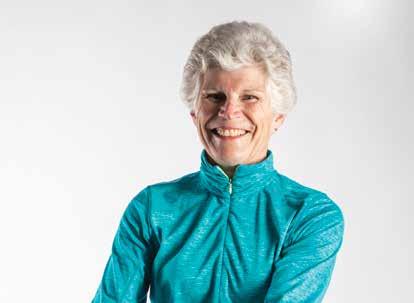
“Do things that make you feel like a kid again: jump off that curb or run to the park with your kids or after your dog. Stretch like your cat. Just move!” — KARLA DEL GRANDE


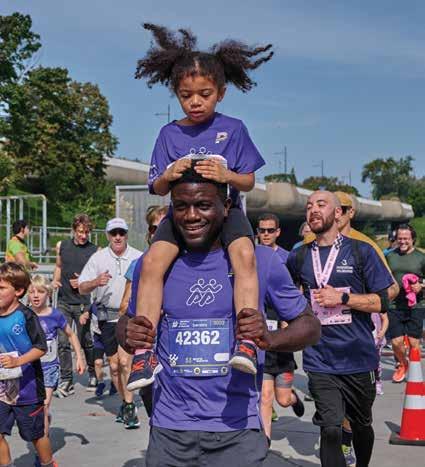

How the Marathon Beneva de Montréal reinvented itself to become Canada’s bucket list race. By Ben Kaplan
While the running boom continues to see participation numbers rise at events across the country, few race weekends have had the success of Marathon Beneva de Montréal. With an entire city behind the province’s flagship run, September’s wild racing weekend has seen exponential growth and extraordinary improvements.
“The Marathon Beneva de Montréal has become the end of season running party of the community,” says Alex Ratthé, executive producer of the event, which now counts twelve different on-course cheering stations organized by local run clubs. “If you’re not running, you’re cheering and our event now has something for everybody— from 5-year-old kids running the 1K to Ethiopian marathoners finishing in 2:09.”
Montréal, of course, is brighter, tastier and more vibrant than just about any city in Canada and the entire spectrum of the country’s most European city is on display at the Marathon Beneva de Montréal. Ratthé, in his third year as the race’s head honcho, says the event’s theme of My Marathon is deeply personal throughout his entire organization. He wants to ensure that the event is truly inclusive—and not just paying lip service to a politically correct term.
“To be more inclusive, we aim to extend our event’s invitation to a diverse range of participants. This includes non-binary individuals,
deaf athletes, and athletes of all ages and abilities, regardless of distance preference. Our goal is to create an event that warmly welcomes everyone,” says Ratthé, adding that his half marathon and marathon courses run entirely through the city and feature no dead zones in terms of crowd support. “When building out our course and programs, from the expo to our finish lines, we truly tried to think about every athlete and what their needs are. I think runners and rollers and walkers from all over the world will see we put tremendous effort behind creating My Marathon experience at the Marathon Beneva de Montréal.”
The event is September 20 through September 22, and race bibs are already selling out fast. When Alex and I spoke for a Globe & Mail piece in April, 17,000 of his 25,000 bibs were already gone. If you’re reading this story, Ratthé says, act fast.
“Montreal is warm and welcoming, we’re a Latin province teeming with restaurants, nightclubs and run groups,” Ratthé says. “When you come to the Marathon Beneva de Montréal, it’s more than just a race. It’s something you’ve never done before.”
The Marathon Beneva de Montréal kicks off September 20 and features events from 1K to 42.2K, and also has distances of 5K, 10K and half marathon. For more information, see mtlmarathon.com.
“Hit the start line with swagger!”
Canada’s best independent running shops offer tips for getting to your next finish line

It’s easy to get caught up in the hype of an event and go out too quickly: dial into your own pace from the start. It feels much better to pass people in the last half the race than to blow up and get passed. This also goes for mass participant events where you have to weave your way through runners. Try not to waste energy trying to squeeze through gaps. It adds extra distance. Nick Walker, Frontrunners
Nothing new on race day! Resist the temptation to try out the new gear you picked up at the expo or use a different sports drink than you have been training with. Erin Pinder, Runner’s Soul Lethbridge

Train slower. And train with Boutique Endurance! We’ve had amazing success for 39 years. Boutique Endurance
Too many runners get caught up in the crowd(s) and go out too quickly. At the start of the race take deep breaths and go out slow and steady. The back half of the race is when you can start picking off your opponents. Runners’ Choice Kingston


Completing something is about motivation, but doing it well is a matter of planning. Get the right equipment from a specialized store and find out about nutrition for your training and train for the same amount of time as your race is going to take: run for two hours in practice before planning to run a two hour half marathon. Rest days are as important as training days and, finally, if you don’t feel ready on race day, you can always switch distances! Boutique Courir Montreal
Be consistent! All great successes are built on a firm foundation, and running is no different. The broader the base, the higher the peak. So stick to what is written on the training program. Keep chipping away at it—with intent. If you do, on race day you can confidently “trust the training.” Lynn Bourque, the Runner’s Shop
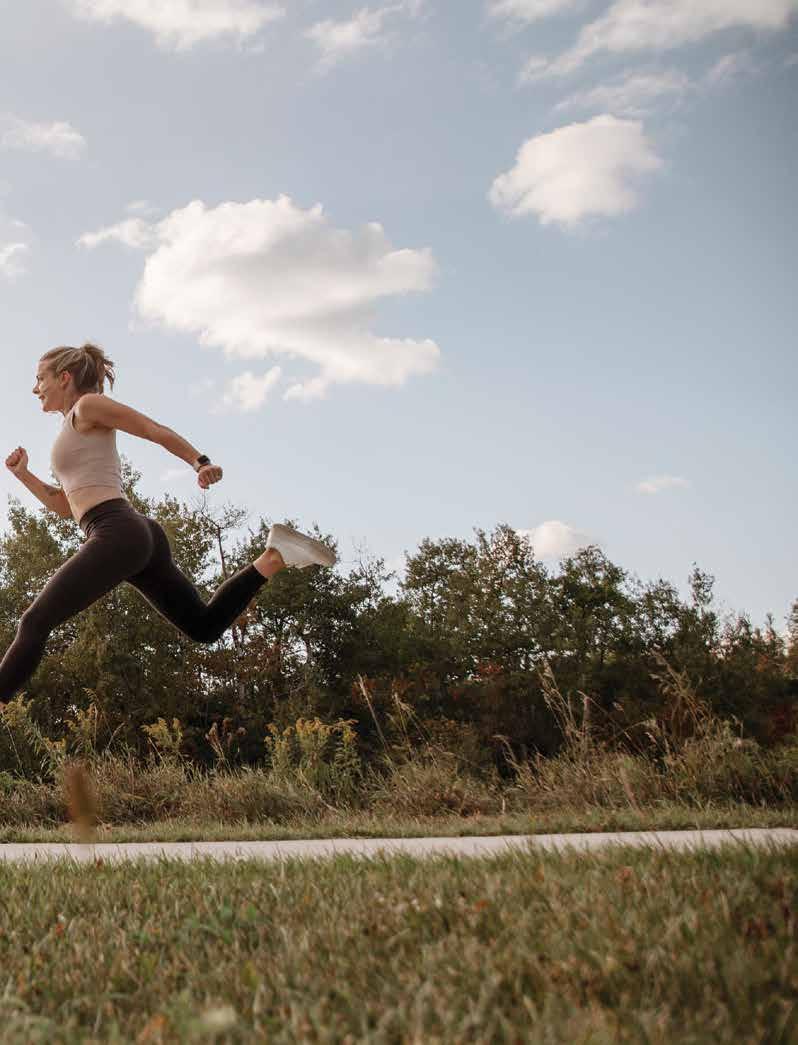
Build more than your fitness, actively build your confidence. Simulate all or part of your race day plan during the training cycle and this includes workouts like simulating race-pace on terrain similar to the course, practicing your race day fueling and pre-race routine and, during the last training week, go over your training history to review all your workouts. Hit the start line swagger! Mike Anderson, BlackToe Running
If you want to run a PB this fall, starting preparing now. Look at your summer vacation schedule and plan your training sessions around them, realizing you may have more (or less) time for training while on holidays. Also, factor in summer heat waves, which may interrupt key workouts or long runs. Jeremy Deere, Strides Running

Do the work, focus on the training process and on race day the outcome will follow! Finding the right plan for you, and then putting your head down and being consistent will set you up for success! A coach is the ideal way to get a personalized plan for you. Mekita, Fast Trax Run & Ski
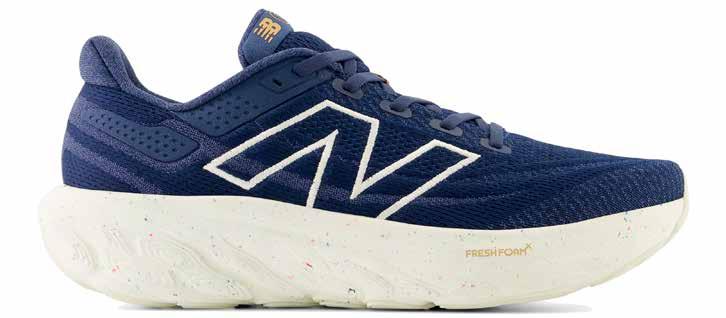
The fastest Canadian marathoner of all-time has thoughts on preparation for your next race
“An easy thing to do—and I did this in high school but it works just as well now—is run pick-ups between lamp posts,” says Cam Levins, who recently matched Ben Flanagan’s 10K record in his preparations for the marathon at the 2024 Paris Olympic Games. The fastest marathon runner in Canadian history, Levins believes an athlete’s training cycle needs eight to ten weeks for a marathon build, and that marathon training involves threading a razor’s edge.
“It’s a thin line between doing everything you can to push yourself forward, and injuring yourself,” says Levins, who gave tips to iRun alongside his esteemed coach, Jim Finlayson. “Towards the end of marathon training I’m doing everything I can to get in big workouts, but you have to blend that with caution, listen to your body and not cross that distress line.”
Coach Finlayson has been running for 40 years and he adds that the point of any marathon build is to ensure the runner trains safely. Training is about consistency and the wise athlete, even someone like Cam Levins, thinks beyond their next race. Training well builds speed and endurance—it also creates a runner for life. “Ultimately,” says Finlayson, “the goal of training is to be able to enjoy this sport for as long as we can.”
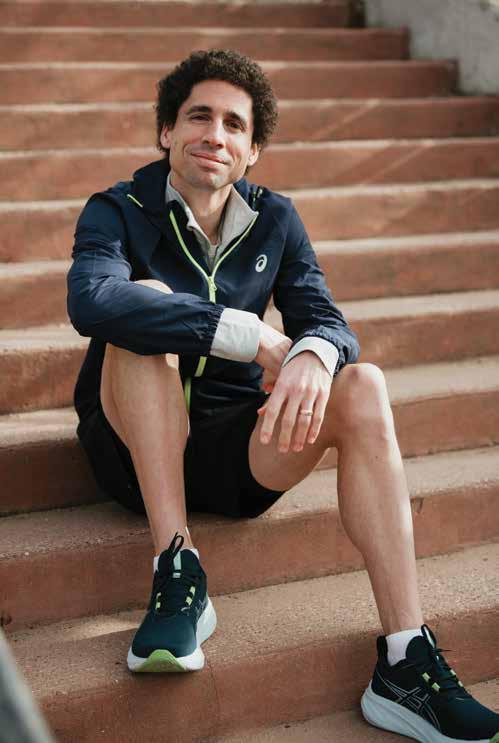
that way you’re working on endurance and speed at the same time.”
Enjoying the sport, of course, for us type-A athletes, also involves scoring PBs. How does Cam do it and how does he hope to do it at the Olympics this summer, against the best in the world? Levins says it’s a mix of experience, diet—taking in calories from carbohydrates and fueling on long runs—preparation, mental and physical, and a well-documented mixture of heavy volume and weightlifting. There is no secret code to unlock to get faster. Levins is still doing today at 35-years-old what he once did as a kid. The difference is that he’s smarter. When pressed, however, he added that pick-ups at the end of long runs has made him a tougher athlete.
“Marathon effort at the end of long runs is a really hard workout—it’s hard to hammer when you’re exhausted—but I found it a good confidence booster and, coaching my brother for his first marathon, a workout that really helped him,” Levins says. “Personally, I like short reps faster than marathon pace mixed in with lots of workouts at my marathon goal pace,
Levins will be running the marathon on August 10 for his country and feels good having tied the 10K Canadian record just a few months out from his race. To get faster, you have to continuously run fast—and there’s no better place to do that than at the races.
“Racing gives you an opportunity to compete and breaks up the training cycle and also, and this is important, it’s fun—you don’t want your training to become boring,” Levins says.
Coach Finlayson agrees. “You want your training to be a positive experience so when you look back you can say you enjoyed it,” Finlayson says.
There’s one last thing Levins mentions with regards to his training for the 2024 Olympics: hills.
“4-minute long hill repeats at half marathon effort with the goal being to run down the hill as quickly as you run back up,” recommends Levins as a last tip for getting strong and fast. “I had only done short hill repeats previously so this was something different, efficient and challenging. It’s impossible doing this exercise to have a short rest.”

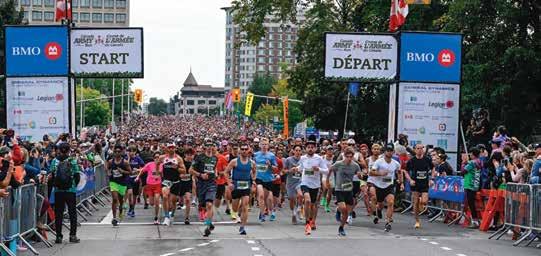

Use code IRUN to save $5!
In-Person: 22 Sep 2024 in O awa
Virtual: 6-27 Sep 2024
5K | 10K | 21.1K | 5K + 10K | 5K +21.1K
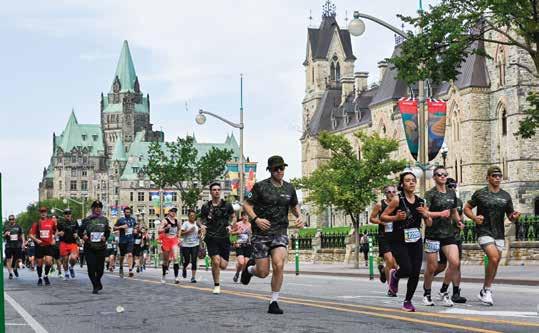




istorically, more women than men participate in 5 and 10 km races. However, recent years have shown an upward trend in the percentage of women racing full marathons. While 42.2 km is not something to take lightly, the reward and accomplishment of completing a marathon is unforgettable and momentous.
As a physiotherapist and running coach, I’ve seen hundreds of athletes prep for the start line. Most will make it, but some falter to a point where they are unable to race. Others will muscle through but declare it an experience never to be repeated, while the most prepared are often hooked and continue on their distance running journey with renewed enthusiasm and fresh goals. What I have learned over the years is that the single determining factor of running a successful marathon isn’t strength training, yoga, stretching, or expensive shoes, but consistency. The ability to commit to a structured training program is absolutely paramount to both completing the marathon as well as enjoying it. This means setting aside protected time
multiple times per week where work or home duties can wait, and having your support system onboard. There are also considerations to be made of where you are in your menstrual cycle, and if you are pre or post-menopause. Marathon training requires an abundance of recovery. This means having continuous access to whole foods, 7-8 hours of sleep per night (at minimum—some studies suggest 8-9 to minimise injury risk), and enough bandwidth to commit to the goal. If you are in a season of life where stress is high and life is already demanding 110% of your energy, it isn’t the time to tackle the marathon.
If you can confidently run 10km without stopping, are currently running 3-4x per week, and are in a healthy place in life where you’re able to push your body and mind, you’ve got the green light to go! We’ve combined the latest coaching research with clinical experience to provide you with the following guide to get you to the start line. Remember there are no hacks with running—it’s simply a matter of putting in the work. And if you’ve got any underlying health factors,
we always recommend a proper assessment with a physiotherapist, naturopath or family doctor and then working with a dedicated run coach to customize your coaching plan. This specific plan is 18 weeks long, with the last two weeks dedicated to taper time. There are active recovery weeks built in, and one hard workout during the week in addition to a weekend long run. It is important to remember that 75-80% of your training should be low and slow; you should be able to hold a conversation during each session.
If you find yourself experiencing pain, seek treatment sooner than later to right the ship before it sinks. Happy running, and we’ll see you at the finish!
Lauren Roberts PT, is a registered physiotherapist and clinic owner of the Running Physio in Toronto. Her staff specializes in working with running-related injuries as well as providing run form analysis. To learn more, visit www.therunningphysio.ca or contact Lauren directly at lauren@therunningphysio.ca.
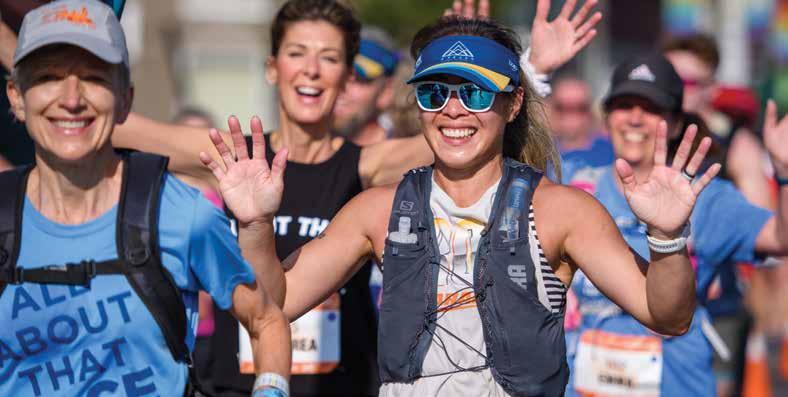
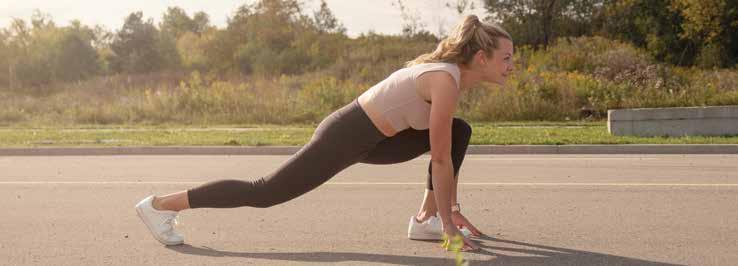
Intervals: 2k Warm Up (WU) followed by 600m hard, 400m easy, repeat 4x, 2k Cool Down (CD)
Intervals: 2k Warm Up (WU) followed by 600m hard, 400m easy, repeat 5x, 2k Cool Down (CD)
Intervals: 2k Warm Up (WU) followed by 600m hard, 400m easy, repeat 6x, 2k Cool Down (CD)
Intervals: 2k WU + 1k moderately hard, 500k easy, repeat 3x, 2k CD
6k
6k
6k
Intervals: 2k WU + 1k moderately hard, 500k easy, repeat 4x, 2k CD
Intervals: 2k WU + 1k moderately hard, 500k easy, repeat 5x, 2k CD
Intervals: 2k WU + 400m hard, 600m easy, repeat 4x, 2k CD
Intervals: 2k WU + 400m hard, 600m easy, repeat 5x, 2k CD
Intervals: 2k WU + 400m hard, 600m easy, repeat 6x, 2k CD
Hill Intervals: hard uphill 1 minute, easy down, repeat 6x
Hill Intervals: hard uphill 1 minute, easy down, repeat 7x
Hill Intervals: hard uphill 1 minute, easy down, repeat 8x
6k
10k

icha Powell is a 2022 Commonwealth Games gold medalist and Canadian Olympic sprinter specializing in the 400m. Born in Montreal to 3x Olympian Rosey Edeh and Long Jump World Record Holder Mike Powell, athletics is a part of her DNA. Micha has her sights set on the 2024 Paris Olympics, and her book, Sprinting Through Setbacks, comes out July 1 with Strong Girl Publishing. Here, Powell introduces us to her life, running and process, in this exclusive excerpted portion of the chapter Trust, which recounts her setting a Quebec indoor track record.
I set process-based goals for each race. This doesn’t look like writing down that I’m going to set a personal best each time. First of all, that’s impossible, and second, it’s not something I can take action on other than by trying to run really fast. Plus, if you continually set goals that you can’t actually hit, you feel like crap every time you don’t hit them.
Your race goal should be a piece of the racing puzzle that is going to make a big enough
A young woman’s lifetime journey as exemplified by her approach to a race
difference in the outcome that it will feel like a win if you make it happen. With a process goal like cutting in first, it isn’t a guarantee that you’ll win because some other girl may be faster. But if I did it, it was definitely going to change the dynamic of the race. At that point, every race where I didn’t cut in first, I didn’t win.
Having a goal like that was a big mindset shift. I could focus just on the cutting in, and there was a good chance that it would lead to a winning result. My strength in the 400 is the second half of the race. So a goal like that felt like I was finally working with myself as opposed to playing by someone else’s race plan.
This was my last chance to make the Indoor Worlds Team for Canada and I was up against some professional American runners, but I was confident. Running with other top pros has its advantages: Even if they beat you, you may run faster because you’re running with them, which meant I was chasing both the win and the qualifying standard.
The track was so busy when I got there. There were hundreds of people: College kids, pro athletes, and so many spectators. Even in the warmup, you had to be careful—you had to stay in your own lane because there were other races happening simultaneously. It was wild.
For World Indoor Track and Field, there are only six lanes versus the eight lanes you have outside. In the 400, I knew the four other girls I was racing with had all been putting up some hot times, all in the 51s, so I was intimidated, but I also felt like today could be my day. When I got to the line for check in, there was only one other girl there. The other girls didn’t show up!
I knew this girl, too. She was faster than me.
Deep breath. I told myself that regardless of how weird the situation was, I was going to trust the process. Cut in first. So I get in my blocks and it still feels so bizarre that we’re the only two runners on the line. I usually prefer running on the outside so I have people chasing me the whole race, but with one other person, it’s almost like you’re running solo.
And when you get into your blocks, you end up creating some kind of mantra or a cue. For me, it’s ‘Push.’ I let a deep breath out when we’re a few seconds from going. The deep breath out is important because when I bring my hips up, press into those blocks with my heels and set my position a second or two from the start, I’m going to breathe in and then hold it until the gun goes. You have to be prepared to really slingshot yourself out to have that good start. When you hear ‘set,’ everything goes blank because you know that in
a matter of two seconds, you’re about to go run as fast as you can in 52 seconds.
So when I breathe in, everything stops, time stops, and I just let my mind go. I’m just waiting for any noise to start running. I’m not listening for a gunshot, I’m listening for a sound.
The gun goes and we start running. And strangely, all I can hear is one person, despite the huge crowded stadium.
When I pushed out of the blocks, I was running like it was a 60 meter race. I’d raced on this track before, the ground felt familiar and I was just in my zone. You don’t always feel this confident and comfortable, but indoor track is nice because even if it’s a new stadium you’re in, you know what it’s going to feel like. So here I am, I’m out and running what feels like a pace that’s so much faster than what I usually can hold. But that’s the whole point, pushing that early pace to cut in first. I’m thinking, “Oh my gosh, here it is, I’m going to cut in first.” I’m closing on the 180 mark and I’m there first, I can hear the other girl breathing down my neck, and I slingshot myself down the track. And I cut in first.
Racing against just one person sounds easier, but mentally, it’s harder. I had to have the audacity to cut in first. That meant being confident enough to challenge her as a specific person, not just as someone in a pack of racers. And I knew she was coming into the race ranked faster than me. But I also think that was to my advantage: When I did cut in first, I think she may have assumed I would fade and she’d be able to come around me. But I know my finish is strong, so even though I figured that she would assume I would fade, I knew that I wouldn’t. Once I got to the front, I locked in.
We hit the 200 meter mark and get the bell for the last lap and I’m running, running, running, completely all out. I’m entirely in my zone, but I can feel the other girl so close to me. Now, everybody’s screaming. Through seeing red, I’m still thinking to myself, “This isn’t as scary as I thought.” When you’re doing it, there’s nothing else but to do it.
I’m still running for all I’m worth, and I know she’s closing. Her shoe grazes the back of my heel, but luckily, I keep my momentum and we don’t both go down. It’s just enough to let me know she’s still right there. I don’t have this yet. Thankfully, I don’t panic, I just take more energy from that. I crossed the finish line first.
I looked over to my left and I saw the time and it was 52.668 seconds. I not only executed my plan, I won the race, I got the Quebec record, and I qualified for the Indoor World Championships in Serbia. Trust the process.
In-person activities and wellness trends are changing the way singles are connecting
hen Noemie Villemure-Poliquin moved to Toronto, she wasn’t looking for love. Relocating from Quebec City to work on her PhD, the 30-year-old wanted to find a way to make local friends. So, leveraging her passion for running, she decided to start a 6am run club, which is where Adam Lu, 24, first laid eyes on her. The pair soon found themselves running together—but it was clear that the friendship was primed to grow into a committed relationship.
The pandemic shifted many aspects of people’s lives—one of the most notable is dating. While people turned to dating apps, now that people are craving in-person experiences, Villemure-Poliquin and Lu’s experience may not be so unique. Are run clubs the new Tinder?
“On the apps, you almost have to sell yourself,” Villemure-Poliquin says. “You have to create
a sales pitch.” Instead, she prefers to meet someone as a friend. “When you meet someone in person, you can see how they act and interact with others. I want to be able to see that before dating someone,” she says.
This is an important aspect that can be missed in the virtual world, according to relationship coach LeAnn Lazar. “When you are in the presence of someone, your bodies integrate many sensory signals that influence attraction,” she says.
And while dating apps are by no means being discontinued, research is showing that their usage is slowing. Apps such as OKCupid, eHarmony, Bumble and Plenty of Fish declined in downloads by 16 percent by 2023, according to mobile analytics provider data.ai.
“While dating apps are still being used, singles are using them more as a Plan B rather than the primary way to meet people,” says Millennial Dating Coach Sheena Sharma.
Not only do run clubs offer a built-in path to making new connections, but they also speak to another societal conversation that’s prevalent in our modern age: The shift towards leading a healthier lifestyle. Wellness trends such as sleep optimization and sobriety lend themselves to seeking healthier ways to meet potential partners.
Sharma says a slew of benefits can come from intertwining your search for love with prioritizing your well-being. “Those who are physically active charge their dopamine, serotonin, and oxytocin receptors frequently, which can lead to lasting love,” she says. Additionally, she says that those who are clocking regular hours through exercise are also more likely to experience integrity in their relationships. “People who are active tend to be growth-oriented, are able to make decisions with a
clearer mind, and have more stable emotions,” she says. “Otherwise, we will be choosing from a place of lack and brain fog, resulting in an incompatible partner and an unfulfilling relationship.”
Connecting through running can also lend itself to developing the tools to weather storms that a relationship may encounter, according to Lazar. “Wellness activities are an opportunity for people to connect through a common interest, a healing journey, or life purpose,” she says. “It helps people show empathy towards each other and discuss ‘heavier’ topics earlier when getting to know each other. All of which can lead to more transparency and deeper connection.”
For Villemure-Poliquin, having a common interest in running has strengthened her relationship. As the relationship grew, running became something the couple could always turn to no matter how busy their lives were. “If we don’t have time to meet for a date, we’ll always make time to meet for a run,” she says.
But a word of caution for those thinking of trading in the apps for clubs: “If you start treating it like a dating pool, it creates weird vibes,” says Villemure-Poliquin.
The key is to use your passion—running or otherwise—to further yourself socially. If it ends in romance, bonus! “I encourage singles not to focus on meeting ‘the one’ every time they meet someone,” says Lazar. And while meeting someone at your run club is awesome, according to Sharma, viewing your weekly run meet-ups as a way to get active, and pursue your goals should be the priority—keeping in mind that you never know where it may lead. “Maybe you won’t find your partner there,” says Villemure-Poliquin “But maybe—maybe—you will.”
Run clubs may be an outlet to meet potential romantic partners, but first and foremost, they’re about making new connections while improving your running. Here’s how your club can foster stronger social connections.
Social Events. Organize social events outside of scheduled runs to encourage members to connect on a more personal level through post-run brunch, weekend potlucks, or gatherings at a local café.
Learning Opportunities. Host workshops, seminars, or guest speaker events on topics such as fitness, nutrition, injury prevention, or mental wellness.
Buddy System. Implement a buddy system or mentorship program to provide support, encouragement, and accountability while fostering connection.
Community Outreach. Partner with local businesses, schools, or community organizations to host events or initiatives such as integrating running into schools or recreational centres.
Club Connections. Avoid the clique mentality and connect with clubs outside of your usual go-to. Newly launched ARunningList.com provides an interactive map detailing the clubs in your area.
Social Media Engagement. Encourage creative ways to communicate such as WhatsApp chats where members can converse about tips, motivation, event photos, or hobbies outside of running.

Stars aligned for Noemie and Adam when he attended a promotional event she was participating in to spread the word about a 6 a.m. run club she had started. Soon, the pair started running together—and the rest was history.
It all began with a single photo—me proudly holding my Chicago marathon medal during an architecture cruise. That image sparked a meaningful connection with Nicole, who swiped right upon seeing that victorious moment. Our first date unfolded during the challenging days of the pandemic and we embraced the freedom of running and cycling. After our runs and rides, we’d unwind with parking lot beers. Having both endured the challenges of marathon training, we understood the dedication and sacrifices required. This shared experience became the cornerstone of our relationship. Our bond is rooted in mutual support, unwavering encouragement, and a deep understanding of each other’s passions.

How we met? She was trying to run away. For us, sharing our love of running has been a way for us to build in more quality time together. Whether we’re racing, cheering, or volunteering at a youth running program, it’s quality time spent side-by-side. Sometimes she even helps remove my nipple Band-Aids.
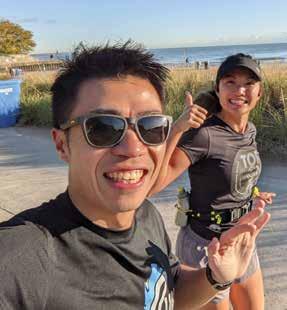
We sparked a conversation about my upcoming Chicago Marathon when I found out he had run it recently. One thing led to another and soon we began training together. Running is good for relationships because it’s a nice way to spend quality time together, and it does not require much skill. Running together keeps us both active and accountable when it comes to our goal of maintaining a healthier lifestyle. Our two pieces of advice to other run couples are: 1) explore new routes and 2) make runs playful. I love dogs and we started a game of seeing who could spot more dogs during our long runs. Initially, our record was spotting 121 dogs on a 15K run. I proudly beat that record when I ran the Chicago Marathon in 2022 by spotting 717 doggos!

As runners we are conditioned to focus on our personal goals, training plans, and reaching for that next PB. At the same time, with the growing concerns of climate change, we all need to consider our environmental impact, and what impact our sport is having for the next generation of runners. From the gear we use to the races we participate in, there are numerous opportunities to contribute positively to the planet. Here are seven ways to be more environmentally friendly.

Sustainable running gear is a significant step towards reducing environmental impact. Look for brands that prioritize eco-friendly materials and production processes. ASICS latest shoe, the NIMBUS MIRAI features FF Blast PLUS ECO cushioning created from 20% or more bio-based materials. You’ll also find companies like ADIDAS and New Balance make running shoes from recycled materials, as well as apparel crafted from organic cotton or recycled polyester. Additionally, you can participate in gear exchange programs to extend the lifespan of
products and reduce waste at your local running stores. Soles4Soles Canada is a great way to donate shoes.
Consider each event’s sustainability. Look for races like the Canada Running Series that prioritize environmentally friendly practices, such as minimizing single-use plastics, implementing recycling programs, and promoting carbon offset initiatives. The Servus Calgary Marathon’s Sustainability Program offers athletes simple ways to reduce their environmental impact including a
medal recycling program and the opportunity to donate shoes. Over in Halifax, the Erma Bluenose Marathon Gold Standard was Atlantic Canada’s first certified Responsible Sporting Event. And in Toronto, the TCS Waterfront Marathon was the first Canadian event to receive Evergreen Certification from the Council for Responsible Sport. Tamarack Ottawa Race Weekend has committed to emission reduction targets of 50% by 2030 and becoming net zero emissions by 2040. Support eco-conscious races.
Running events requiring travel contribute to carbon emissions. Whenever possible, opt for races that are close to home or accessible by public transportation. Runners of all distances at the BMO Vancouver Marathon can travel conveniently, thanks to travel passes and shuttle service from Translink courtesy of RUNVAN, the non-profit event organizers. If you need to drive to the startline, consider carpooling. And with all the options available, consider participating in virtual races, which eliminate the need for travel altogether while still allowing you to compete and contribute to charitable causes (We love ReconciliationRun.ca).
Leave natural spaces as pristine as you found them. Practice leave-no-trace principles by staying on designated trails, avoiding trampling vegetation, and properly disposing of waste. Bring along a reusable water bottle and energy gels in reusable packaging to minimize single-use plastic waste. By respecting the environment while running, you help preserve natural habitats and ensure they remain enjoyable for future generations of runners. Some trail runners are taking it a step further, lessening their environmental impact by plogging—a combination of jogging and collecting litter while on the trails. Check out the TransCanada Trail for planting and plogging community events all year.
Consider the environmental impact of our dietary choices. Opt for locally sourced, organic foods whenever possible to reduce the carbon footprint associated with transportation and conventional farming practices. Incorporate plantbased options into your diet, as plant-based foods generally have a lower environmental impact
compared to animal products. When it comes to grab-and-go options, CLIF offers a wide variety of products with sustainability certifications, which means that the company sources ingredients according to environmentally conscious practices. And when you’re meal prepping for the week ahead, minimize food waste by planning carefully and composting food scraps.
Running, unfortunately, contributes to our carbon footprint, through bibs, shirts, medals, shoes, travel and energy consumption. ASICS carbon footprint label featured on shoes including GEL-NIMBUS 26, enables runners to learn more about the carbon emissions at each stage of a product’s lifecycle. From the materials to manufacturing to transportation, ASICS is showing runners the steps being taken to consistently reduce carbon emissions. Also, offset programs are a way to support the environment by raising awareness. Consider offsetting your carbon footprint by investing in carbon offset programs or supporting reforestation initiatives. Many organizations offer carbon calculators that estimate your emissions from running-related activities
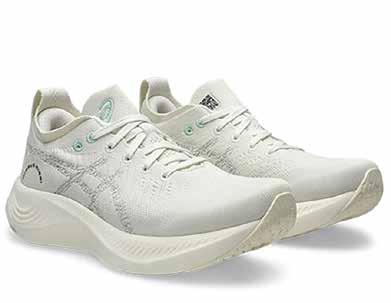
and allow you to offset them by funding projects that reduce greenhouse gas emissions or capture carbon from the atmosphere.
Use your platform as a runner to educate others about the importance of environmental sustainability. Share tips and resources for reducing environmental impact within the running community and advocate for eco-friendly practices in races and events. Encourage race organizers to prioritize sustainability initiatives and support brands that demonstrate a commitment to
environmental stewardship. By raising awareness and promoting positive change, we can collectively make a significant impact in preserving the planet for future generations of runners.
Runners have a unique opportunity to minimize our environmental impact and contribute to a more sustainable future. By making conscious choices regarding gear, races, transportation, nutrition and advocacy, runners can help protect the planet’s natural resources. Running Green isn’t just about achieving personal goals; it’s about taking responsibility for our impact on the environment—within the running community and beyond.
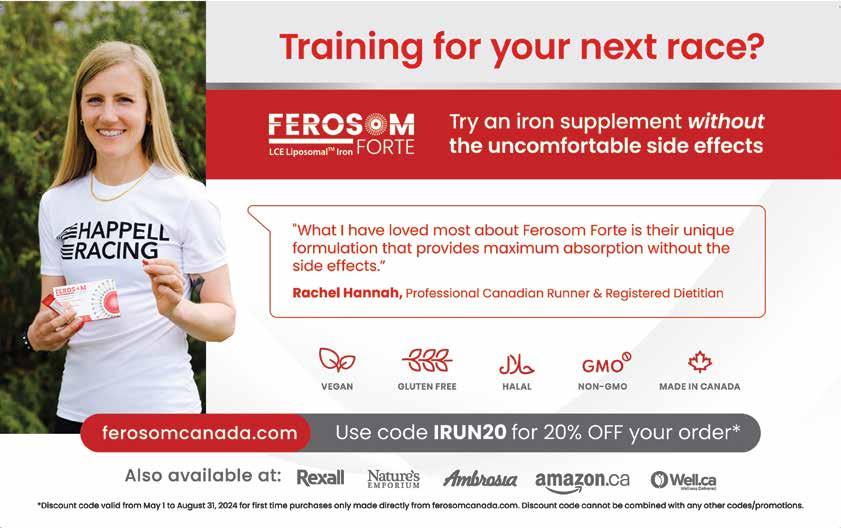
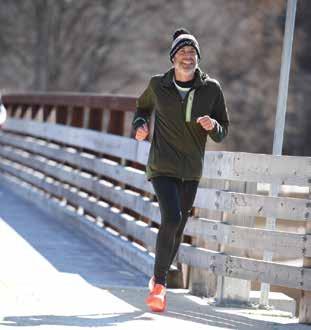
I almost cancelled my last race because of what was going to happen after it. Recently I was diagnosed with a large kidney tumour and it never sunk in, but what happened was the operation date kept getting closer. I wasn’t thinking about it. I was busy. Except: sometimes I couldn’t sleep. And my friends and parents began to worry, which was lovely, but also I didn’t want to upset my kids. A desire overcame me to not do anything. Clear all plans. Answer no phone calls. Basically: hide, and quietly await what was coming.

empowering. I took a bus with friends from BlackToe to Hamilton from Toronto. I very carefully made my playlist extra sweet. It was only thirteen songs and I played them on repeat: Free Fallin’, I Won’t Back Down, Lost Together. You know the vibe: set your spirit free.
I had no time goal and I dressed as if I was scaling the arctic. Much too many layers but none of that mattered: not the extra distance, not my pace, not my sneakers, not anything. There were people I knew at the start line and even the people I didn’t know—the runners waiting to begin—I knew them. I know us. How we all feel before race day. The weeks leading in, the night before. I was scared, absolutely. If we’re honest, we’re all scared—we all have our problems, our own reasons not to run.
When the horn went off and I started moving, the music started playing and I saw the cheers—my soul lifted, soared.
The day was sunny and the route was good. There were hills and water stations and times when I felt like flying—and other times when I had to walk. But I had travelled a great distance, emotionally, from being frightened to feeling exalted; not sick, beaming. My troubles, like everything, I knew would still be there when I crossed the finish line.
They weren’t with me now.
Having a kidney removed isn’t the end of the world. Each week we write about people facing much greater adversities and I’m going to be fine. The idea is to make my return in November with my running partner at the TCS New York Marathon. We shall see. But I also return to this question after so many years: why do I run? Is it to stay fit, be social, have something to look forward to—arbitrary goals on the calendar to keep me engaged with the world?
It’s all those things and I’m sure it’s some combination of all those things for you. I raced that Sunday because we can’t change what’s going to happen, but we can change how we spend the days leading up to the rest of our lives. Hiding in the basement isn’t going to solve anything and being outdoors with friends, listening to Tom Petty, hearing cheers, getting exercise and crossing a finish line—my lord, talk about hobbies.
Something I hope we can share for all of the rest of our lives.
“The idea that I can do more than I’ve done, fuels me.”
Malindi Elmore has run five of the ten fastest women’s marathons in Canadian history and finished ninth at the 2020 Summer Olympics in Tokyo. She cites big dreams for helping her elevate our sport.

Malindi Elmore: three time Olympian, fastest Canadian woman ever at Boston and preparing to run the marathon—at 44—at the 2024 Paris Olympic Games. Ahead of her historic journey, iRun caught up with Elmore and asked her to take the temperature of our world.
iRun: Your third Olympic Games start in two months, how do you feel?
Malindi Elmore: At 20-years-old I certainly never imagined I’d be going to a third Olympics—especially at 44.
iRun: What excites you most about our sport?
ME: The idea that I can do more than I’ve done has always fueled me.
iRun: From college to motherhood, how has
running changed and how has our sport stayed the same?
ME: Everything’s changed, but one step in front of the other, connecting with myself, my dreams, my ideas and other people—through running—has stayed the same.
iRun: How does running allow you to connect with yourself?
ME: By offering a chance to slow down and actually have time to think.
iRun: Have you learned one simple thing for longevity?
ME: Don’t run through injuries.
iRun: Can you explain that for us middle-ofthe-pack joggers?
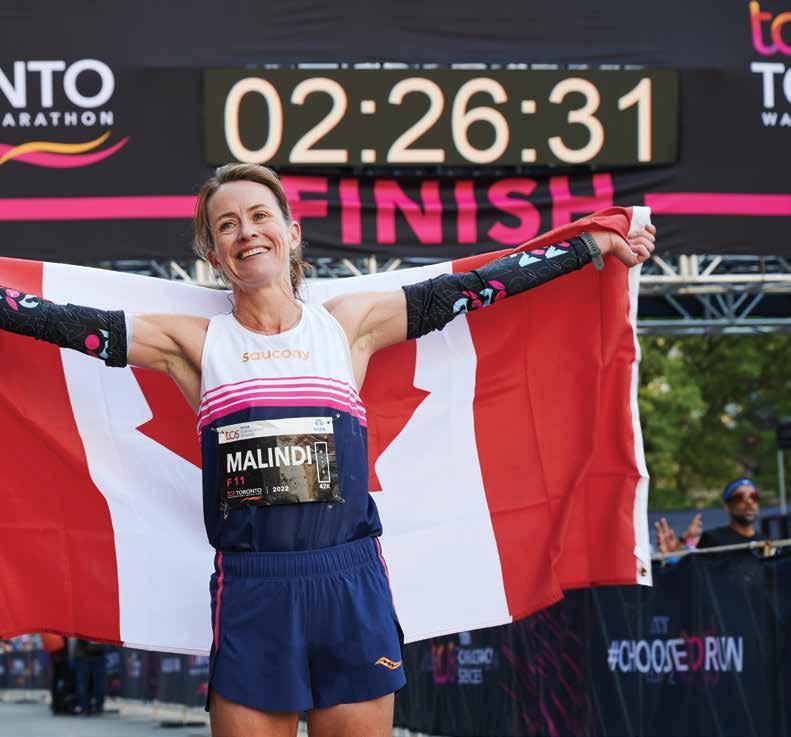
ME: Prioritize sleep, eating well and stress-management. That will not only make any runner feel better, but also lead to better performances and better motivation.
iRun: It takes courage sometimes to run less.
ME: I was supposed to run Boston and my hamstring wasn’t great and we decided to pull the plug. When I was younger, I would’ve run through it and put myself in a position where I needed to take three months off because of injury.
iRun: This issue is female-forward with a lens on increasing female participation, at all ages, in sport. How would you improve access to exercise for women?
ME: We need to give girls confidence through
puberty and the teenage years.
iRun: How?
ME: Keep the focus on fun and remind young women that the priority should be process, not result-based, goals.
iRun: What’s your goal for the 2024 Paris Olympic Games?
ME: A top ten finish like last time would be amazing.
iRun: I’m sure you’ve sussed out the course. ME: Twice the elevation of Boston—epic, unlike any other marathon. So being patient and working on finishing the last 10K strong is the plan. I want to come off the hills with strength
in my legs and run people down.
iRun: How have you prepared to run down the fastest marathoners in the world, half your age, at the end of a race twice as hard as Boston?
ME: Running hills and being strong in the weight room.
iRun: Can you go faster than 2:23:30—take off fifteen seconds and become, again, Canada’s fastest marathon runner of all-time?
ME: The goal is to break my personal record and run under 2:23. Run a 2:22—or faster.
iRun: Could you do that later in life, say when you’re 49?
ME: Why not?



